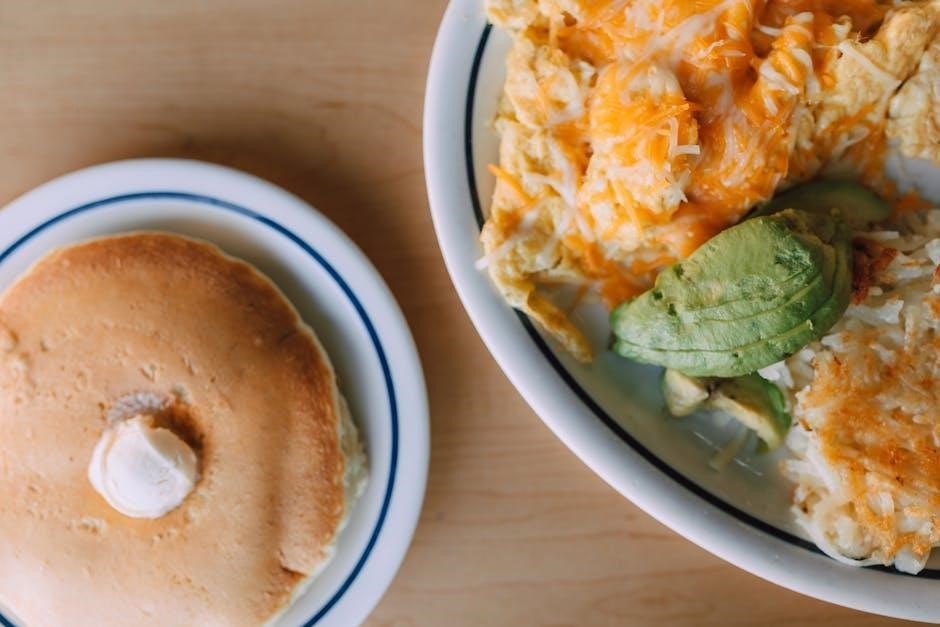Insulin resistance occurs when the body’s cells don’t respond effectively to insulin‚ disrupting blood sugar regulation. A well-structured diet focusing on low-GI foods and whole‚ unprocessed ingredients can help manage this condition‚ improving insulin sensitivity and overall metabolic health.
1.1 Understanding Insulin Resistance
Insulin resistance occurs when cells fail to respond effectively to insulin‚ a hormone regulating blood sugar. This leads to higher blood glucose levels‚ increasing the risk of type 2 diabetes and metabolic syndrome. Causes include obesity‚ physical inactivity‚ and genetics. Over time‚ insulin resistance strains the pancreas‚ potentially reducing insulin production. Managing this condition often involves dietary adjustments to stabilize blood sugar and enhance insulin sensitivity. A structured meal plan focusing on low-GI foods‚ whole ingredients‚ and balanced nutrition can significantly improve insulin function and overall health. Understanding the condition is the first step toward effective management.
1.2 The Role of Diet in Managing Insulin Resistance
Diet plays a crucial role in managing insulin resistance by stabilizing blood sugar levels and improving insulin sensitivity. Emphasizing whole‚ unprocessed foods‚ such as vegetables‚ lean proteins‚ and healthy fats‚ helps regulate glucose metabolism. Low-glycemic index foods‚ like whole grains and legumes‚ prevent rapid spikes in blood sugar. Avoiding processed carbs and sugary foods reduces insulin demand. A structured meal plan not only supports metabolic health but also promotes sustainable weight management‚ enhancing overall bodily function. Strategic dietary choices are foundational in combating insulin resistance and preventing related health complications. This approach fosters long-term well-being and disease prevention.


Key Principles of an Insulin Resistance Meal Plan
A successful insulin resistance meal plan emphasizes low-glycemic foods‚ balanced macronutrients‚ and whole‚ unprocessed ingredients. This approach stabilizes blood sugar‚ enhances insulin sensitivity‚ and promotes metabolic health.
2.1 Focus on Low-Glycemic Index Foods
Low-glycemic index foods are essential for managing insulin resistance. These foods‚ such as whole grains‚ non-starchy vegetables‚ and legumes‚ digest slowly‚ preventing sudden blood sugar spikes. By choosing low-GI options like quinoa‚ brown rice‚ and sweet potatoes‚ individuals can maintain stable blood sugar levels. This approach reduces the strain on insulin production and improves the body’s ability to regulate glucose effectively. Incorporating these foods into meals helps promote long-term metabolic health and supports overall well-being. Regularly selecting low-GI ingredients is a cornerstone of an effective insulin resistance meal plan.
2.2 Balancing Carbohydrates‚ Proteins‚ and Fats
Balancing carbohydrates‚ proteins‚ and fats is crucial for managing insulin resistance. Carbohydrates should be low in glycemic index to avoid blood sugar spikes‚ while proteins like lean meats and legumes help regulate hunger and muscle repair. Healthy fats‚ such as avocados and nuts‚ support hormone production and satiety; Combining these macronutrients in each meal promotes steady blood sugar levels and enhances insulin sensitivity. Portion control and avoiding processed foods are key to maintaining this balance effectively. This balanced approach ensures sustainable energy and supports overall metabolic health.
2.3 Importance of Whole‚ Unprocessed Foods
Whole‚ unprocessed foods are essential for managing insulin resistance as they provide natural nutrients without added sugars or unhealthy fats. These foods‚ such as vegetables‚ whole grains‚ and lean proteins‚ are rich in fiber and antioxidants‚ which help regulate blood sugar levels and improve insulin function. Avoiding processed foods minimizes exposure to harmful additives that can worsen insulin resistance. Incorporating whole foods into meals ensures a balanced diet‚ supports metabolic health‚ and promotes sustainable weight management. This approach fosters a healthier relationship with food and enhances overall well-being.

Food Choices for Insulin Resistance
Selecting the right foods is crucial for managing insulin resistance. Focus on nutrient-rich‚ whole foods like vegetables‚ lean proteins‚ and healthy fats to stabilize blood sugar levels.
3.1 Best Protein Sources
Lean proteins are essential for managing insulin resistance as they help stabilize blood sugar and provide satiety. Opt for sources like grilled chicken‚ turkey‚ fish‚ and plant-based options such as legumes‚ lentils‚ and tofu. These proteins are rich in nutrients and low in saturated fats‚ making them ideal for regulating insulin levels. Avoid processed meats and choose organic or grass-fed options when possible. Incorporating a variety of protein sources ensures a balanced diet and supports overall metabolic health‚ helping to improve insulin sensitivity over time.
3.2 Healthy Fats to Include
Healthy fats play a crucial role in managing insulin resistance by improving insulin sensitivity and providing sustained energy. Incorporate sources like avocados‚ nuts‚ seeds‚ and olive oil‚ which are rich in monounsaturated and polyunsaturated fats. These fats help stabilize blood sugar levels and reduce inflammation. Avoid processed and trans fats‚ as they can worsen insulin resistance. Fatty fish‚ such as salmon and mackerel‚ are also beneficial due to their omega-3 content. Healthy fats should be consumed in moderation as part of a balanced diet to support overall metabolic health and blood sugar regulation.
3.3 Low-GI Carbohydrates for Stable Blood Sugar
Low-glycemic index (GI) carbohydrates are essential for maintaining stable blood sugar levels‚ which is critical for managing insulin resistance. Focus on whole‚ unprocessed foods like quinoa‚ brown rice‚ oats‚ and non-starchy vegetables such as broccoli and spinach. These foods digest slowly‚ preventing sharp blood sugar spikes. Include low-GI fruits like berries‚ apples‚ and pears‚ but monitor portion sizes. Avoid refined grains and sugary foods‚ which have high GI values and can exacerbate insulin resistance. Pairing carbs with protein or healthy fats further stabilizes blood sugar‚ enhancing metabolic control and overall health.
3.4 Vegetables: Focus on Non-Starchy Options
Non-starchy vegetables are a cornerstone of an insulin resistance meal plan‚ as they provide essential nutrients without causing significant blood sugar spikes. Opt for leafy greens like spinach‚ kale‚ and broccoli‚ as well as colorful vegetables such as bell peppers‚ zucchini‚ and cucumbers. These options are rich in fiber‚ vitamins‚ and antioxidants‚ which support overall metabolic health. Avoid starchy vegetables like potatoes‚ corn‚ and peas‚ which have higher GI values. Incorporating a variety of non-starchy vegetables ensures balanced nutrition and helps stabilize blood sugar levels‚ making them a key component of insulin-friendly meals.

Meal Planning Strategies
- Emphasize balanced macronutrient distribution to stabilize blood sugar.
- Plan meals with portion control and timed eating.
- Prioritize whole‚ unprocessed foods for optimal insulin response.
- Space meals evenly to avoid blood sugar spikes.
4.1 Breakfast Options to Stabilize Blood Sugar
Starting your day with a balanced breakfast is crucial for maintaining blood sugar control. Opt for protein-rich options like scrambled eggs with spinach or Greek yogurt topped with chia seeds and berries. Incorporate healthy fats such as avocado or nuts to slow down carbohydrate digestion. whole-grain toast or oatmeal can be included in moderation‚ but choose low-GI varieties to prevent spikes. Avoid sugary cereals and pastries‚ which can disrupt insulin balance. Pairing protein with fiber and fats ensures a steady energy release‚ setting a positive tone for the rest of the day.
4.2 Balanced Lunch Ideas
A balanced lunch for insulin resistance should combine lean proteins‚ healthy fats‚ and low-GI vegetables. Consider options like grilled chicken salad with avocado‚ olive oil dressing‚ and mixed greens. Whole-grain wraps with lean turkey‚ spinach‚ and hummus are also ideal. Include a side of roasted non-starchy vegetables like broccoli or bell peppers. Quinoa or brown rice bowls with chickpeas‚ cucumber‚ and a drizzle of olive oil provide sustained energy. Avoid processed carbs and opt for fiber-rich sides like a small apple or a handful of nuts. Portion control is key to maintaining blood sugar stability and overall metabolic balance.
4.3 Healthy Dinner Choices
Healthy dinner choices for insulin resistance focus on balanced‚ nutrient-dense meals. Opt for baked or grilled lean proteins like salmon‚ chicken‚ or turkey. Pair with low-GI vegetables such as spinach‚ Brussels sprouts‚ or asparagus. Incorporate healthy fats like olive oil or avocado to enhance satiety and insulin function. Small portions of complex carbs like quinoa or brown rice can also be included. Avoid processed foods and refined sugars. A sample dinner could be grilled chicken with roasted vegetables and a side of sautéed mushrooms. Portion control and mindful eating are key to maintaining blood sugar stability and promoting overall metabolic health.
4.4 Snacking Wisely
Snacking wisely is crucial for maintaining blood sugar stability and insulin sensitivity. Choose snacks rich in protein‚ healthy fats‚ and low-GI carbohydrates. Nuts‚ seeds‚ and hard-boiled eggs are excellent options. Vegetables like cucumber‚ bell peppers‚ or carrots paired with hummus or guacamole provide fiber and nutrients. Opt for small portions of Greek yogurt or cottage cheese for protein and calcium. Avoid sugary or refined snacks‚ as they can spike blood sugar. Portion control is key to prevent overeating. Snacks should bridge meals without causing insulin spikes‚ supporting overall metabolic health and energy balance throughout the day.

Sample 7-Day Meal Plan
This meal plan provides balanced‚ nutritious options to help manage insulin resistance. Each day includes breakfast‚ lunch‚ dinner‚ and snacks‚ focusing on protein‚ healthy fats‚ and low-GI carbs.
Start your week with meals that emphasize low-glycemic index foods to stabilize blood sugar levels. Breakfast: Greek yogurt with berries and chia seeds. Lunch: Grilled chicken salad with mixed greens‚ avocado‚ and olive oil dressing. Dinner: Baked salmon‚ quinoa‚ and steamed broccoli. Snack: Almonds and a small apple. These meals focus on lean proteins‚ healthy fats‚ and low-GI carbohydrates to promote insulin balance and energy stability throughout the day.
5.2 Day 2: Incorporating Lean Proteins
Day 2 highlights lean proteins to support muscle health and satiety. Breakfast: Scrambled eggs with spinach and a slice of whole-grain toast. Lunch: Turkey lettuce wraps with avocado and tomato‚ served with a side of roasted sweet potato fries. Dinner: Grilled turkey breast with cauliflower rice and sautéed green beans. Snack: A hard-boiled egg and a handful of walnuts. These protein-rich meals help regulate blood sugar and provide sustained energy‚ aligning with the goals of an insulin resistance meal plan.
5.3 Day 3: Focus on Fiber-Rich Foods
Day 3 emphasizes fiber-rich foods to slow digestion and stabilize blood sugar. Breakfast: Oatmeal with chia seeds‚ berries‚ and a sprinkle of walnuts. Lunch: Quinoa salad with roasted vegetables like broccoli‚ spinach‚ and chickpeas. Dinner: Grilled salmon with asparagus and Brussels sprouts. Snack: Sliced cucumber and bell peppers with hummus. Fiber-rich meals promote satiety‚ improve insulin sensitivity‚ and support gut health‚ aligning with the principles of a balanced insulin resistance diet.
5.4 Day 4: Healthy Fats in Meals
Day 4 highlights the importance of incorporating healthy fats to enhance satiety and support insulin function. Breakfast: Scrambled eggs with avocado slices and a sprinkle of cheese. Lunch: Grilled chicken salad with olive oil dressing‚ mixed greens‚ and almonds. Dinner: Baked cod with a side of sautéed spinach and olive oil. Snack: A small handful of mixed nuts like almonds and walnuts. Healthy fats‚ such as avocados‚ nuts‚ and olive oil‚ promote balanced blood sugar levels and provide essential nutrients for overall health.
5.5 Day 5: Balanced Carbohydrate Intake
Day 5 focuses on balancing carbohydrate intake to maintain stable blood sugar levels. Breakfast: Oatmeal with berries and a sprinkle of chia seeds. Lunch: Grilled turkey breast with quinoa and steamed broccoli. Dinner: Roasted sweet potato with lean ground beef and green beans. Snack: Sliced cucumber with hummus. Emphasize complex carbs like whole grains‚ vegetables‚ and legumes‚ paired with proteins and healthy fats to regulate digestion and insulin response‚ ensuring sustained energy and metabolic balance throughout the day.
5.6 Day 6: Vegetarian Meal Options
Day 6 highlights vegetarian choices rich in fiber and protein to support insulin sensitivity. Breakfast: Greek yogurt with mixed berries and a drizzle of almond butter. Lunch: Quinoa salad with roasted chickpeas‚ spinach‚ and avocado. Dinner: Grilled portobello mushrooms with brown rice and sautéed kale. Snack: Carrot sticks with guacamole. These plant-based meals provide balanced nutrients‚ focusing on whole grains‚ legumes‚ and healthy fats to stabilize blood sugar and enhance metabolic function without relying on animal products.
5.7 Day 7: Review and Adjustment
Day 7 is about reviewing your progress and making necessary adjustments. Start with a protein-packed breakfast like scrambled eggs with spinach and avocado. For lunch‚ opt for a grilled vegetable wrap with lean hummus. Dinner could be lentil soup with a side of roasted broccoli. Use this day to assess how your body has responded to the meal plan and tweak portions or food choices as needed. Focus on hydration and light physical activity to enhance insulin sensitivity. Adjustments should prioritize whole‚ unprocessed foods and balanced macronutrient intake for sustained metabolic health.

Lifestyle Factors to Enhance Insulin Sensitivity
Lifestyle factors play a crucial role in improving insulin sensitivity. Regular physical activity‚ stress management‚ and adequate sleep are essential for maintaining metabolic health and promoting insulin function effectively.
6.1 The Importance of Regular Exercise
Regular exercise is a cornerstone of improving insulin sensitivity. Physical activity helps cells respond better to insulin‚ reducing blood sugar levels. Aerobic exercises like walking or cycling‚ and strength training‚ can enhance glucose uptake in muscles. Even moderate movement‚ such as daily walks‚ can make a significant difference. Consistency is key‚ as exercising regularly helps maintain healthy insulin function and overall metabolic health; Incorporating exercise into your routine complements dietary changes‚ promoting long-term benefits for managing insulin resistance.
6.2 Managing Stress Levels
Chronic stress can negatively impact insulin sensitivity by increasing cortisol levels‚ which may lead to blood sugar imbalances. Effective stress management is essential for maintaining metabolic health. Techniques such as yoga‚ deep breathing exercises‚ or meditation can help reduce stress and improve insulin function. Prioritizing activities that promote relaxation and scheduling downtime can also contribute to better overall well-being. By incorporating stress-reduction practices into your daily routine‚ you can enhance your body’s ability to regulate blood sugar and support long-term insulin health.
6.3 Adequate Sleep for Metabolic Health
Adequate sleep plays a crucial role in maintaining metabolic health and insulin sensitivity. Poor sleep quality or insufficient sleep duration can disrupt hormones that regulate blood sugar‚ leading to insulin resistance. Aiming for 7-9 hours of quality sleep per night helps stabilize blood sugar levels and supports weight management. Establishing a consistent sleep schedule‚ creating a relaxing bedtime routine‚ and minimizing screen time before bed can improve sleep quality. Prioritizing sleep is an essential component of a comprehensive strategy to enhance insulin sensitivity and overall metabolic function.

Monitoring and Adjusting Your Meal Plan
Regularly tracking blood sugar levels and assessing how your body responds to meals is essential for optimizing your insulin resistance diet. Adjust portions and food choices based on blood sugar trends‚ ensuring balanced carbohydrate intake and overall metabolic stability. Consistency in monitoring allows for timely modifications‚ enhancing the effectiveness of your meal plan and supporting long-term health goals.
7.1 Tracking Blood Sugar Levels
Monitoring blood sugar levels is crucial for understanding how your diet affects insulin resistance. By testing blood glucose before and after meals‚ you can identify which foods cause spikes and adjust your intake accordingly. This data helps refine your meal plan‚ ensuring it aligns with your metabolic needs. Consistent tracking also reveals patterns over time‚ enabling better decision-making and promoting stable blood sugar levels. Regular monitoring fosters accountability and empowers you to make informed choices‚ enhancing the overall success of your insulin resistance management strategy.
7.2 Adjusting Portions and Food Choices
Regularly assessing and adjusting your portion sizes and food selections is vital for managing insulin resistance. By evaluating how different foods impact your blood sugar levels‚ you can tailor your diet to prioritize low-GI options and balanced macronutrient intake. Adjusting portions ensures you’re not overconsuming carbohydrates or unhealthy fats‚ which can hinder progress. Fine-tuning your food choices based on blood sugar responses and metabolic goals allows for a more personalized approach‚ enhancing the effectiveness of your meal plan and supporting long-term insulin sensitivity improvement.

Common Mistakes to Avoid
Overconsumption of processed foods‚ ignoring portion sizes‚ and skipping meals are common errors that can hinder progress in managing insulin resistance. Avoid these pitfalls for better results.
8.1 Overconsumption of Processed Foods
Processed foods are often high in unhealthy ingredients like refined sugars‚ artificial additives‚ and harmful fats‚ which can spike blood sugar levels and worsen insulin resistance. Regular consumption of these foods leads to chronic inflammation and metabolic dysfunction‚ making it harder for the body to regulate glucose effectively. To avoid this‚ focus on whole‚ unprocessed foods such as vegetables‚ lean proteins‚ and whole grains‚ which provide essential nutrients without the harmful side effects. This shift supports better insulin sensitivity and overall health.
8.2 Ignoring Portion Sizes
Ignoring portion sizes can lead to overeating‚ even if the food is healthy. Consuming large portions of carbohydrates‚ proteins‚ or fats can overwhelm the body‚ causing blood sugar spikes and insulin overload. This can exacerbate insulin resistance and hinder weight management. Using smaller plates‚ measuring portions‚ and eating mindfully helps maintain balance. Even nutrient-dense foods‚ when overeaten‚ can negatively impact metabolic health. Awareness of serving sizes ensures meals stay effective in supporting insulin sensitivity and overall well-being. Balancing quantity with quality is key to a successful insulin resistance meal plan.
8.3 Skipping Meals
Skipping meals can disrupt blood sugar balance and worsen insulin resistance. When meals are skipped‚ the body may experience blood sugar spikes followed by crashes‚ leading to overeating or poor food choices. This irregular pattern can strain insulin function‚ making cells less responsive over time. Additionally‚ skipping meals can reduce metabolism and energy levels‚ further complicating weight management and metabolic health. Consistent‚ balanced meals help maintain stable blood sugar levels and support insulin sensitivity‚ making regular eating a cornerstone of an effective insulin resistance meal plan.

Resources for Implementing the Meal Plan
Accessing resources like printable PDF guides‚ online communities‚ and mobile tracking apps can simplify meal planning and tracking. These tools provide structured support and motivation.
9.1 Printable PDF Guides
Printable PDF guides offer a structured approach to managing insulin resistance. These resources often include detailed meal plans‚ grocery lists‚ and recipes tailored to improve insulin sensitivity. They provide clear‚ actionable steps for implementing a low-GI diet‚ focusing on whole‚ unprocessed foods. Many PDF guides are designed to be user-friendly‚ allowing individuals to track their progress and stay motivated. By following these guides‚ one can create balanced meals that support metabolic health and sustainable weight loss. They are ideal for those seeking a straightforward‚ organized method to enhance their dietary habits.
9.2 Online Communities and Forums
Online communities and forums provide valuable support for individuals managing insulin resistance. These platforms allow users to share experiences‚ ask questions‚ and receive advice from others on similar journeys. Many forums offer access to expert tips‚ meal ideas‚ and resources for implementing a low-GI diet. They also serve as motivation hubs‚ where members can track progress and celebrate successes. Engaging with these communities fosters a sense of belonging and accountability‚ making it easier to adhere to a meal plan. They are particularly useful for gaining practical insights and staying informed about the latest dietary strategies.
9.3 Mobile Apps for Tracking
Mobile apps are powerful tools for tracking progress on an insulin resistance meal plan. They help users monitor food intake‚ blood sugar levels‚ and physical activity. Many apps offer features like food diaries‚ barcode scanners‚ and carb counting to simplify meal planning. Some apps also provide personalized recommendations based on dietary goals. Additionally‚ they often include community support features‚ allowing users to share experiences and stay motivated. These tools enable real-time insights‚ helping individuals make informed decisions to improve insulin sensitivity and maintain a healthy lifestyle. They are indispensable for anyone seeking to manage their condition effectively.
Adopting an insulin resistance meal plan requires commitment to dietary and lifestyle changes. Focus on low-GI foods‚ balanced meals‚ and regular monitoring to enhance insulin sensitivity and overall health.
10.1 Recap of Key Points
An effective insulin resistance meal plan focuses on low-GI foods‚ balanced macronutrients‚ and whole‚ unprocessed ingredients. Prioritizing lean proteins‚ healthy fats‚ and fiber-rich vegetables supports blood sugar stability. Regular physical activity‚ stress management‚ and adequate sleep further enhance insulin sensitivity. Consistency is key‚ as small dietary changes can lead to significant improvements in metabolic health. Monitoring blood sugar levels and adjusting portions ensures the plan remains effective. By adhering to these principles‚ individuals can better manage insulin resistance and promote long-term wellness. Stay committed to the plan for sustainable results.
10.2 Encouragement for Long-Term Adherence
Maintaining an insulin resistance meal plan requires dedication‚ but the benefits are profound. Celebrate small victories‚ like improved energy levels or better blood sugar control‚ to stay motivated. Focus on gradual changes rather than quick fixes‚ allowing your body time to adapt. Remember‚ this is a journey toward a healthier lifestyle‚ not a temporary diet. By staying consistent and patient‚ you can achieve lasting improvements in insulin sensitivity and overall well-being. Keep in mind‚ every healthy choice brings you closer to your long-term health goals. Stay committed and embrace the positive impact on your life.